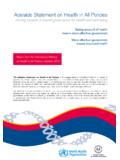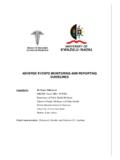Transcription of Book SYNOPSIS - pages - NITI AAYOG
1 A SYNOPSISI ndia is on a high growth trajectory and has been for a while now. This growth needs to be accelerated while realizing the Honourable Prime Minister's Vision of "Sabka Saath Sabka Vikaas." High growth rates can be achieved and sustained when the private sector s dynamism and innovative spirit is channelled towards the country's growth and betterment. This focus can be attained when both the private sector and government work collaboratively. To facilitate this partnership, NITI AAYOG has organized an interactive conference over two days on August 16 and 17, 2017. This conference, Champions of Change, aims to foster conversations between the private sector and representatives from the government, including the Honourable Prime Minister of India.
2 Over the last few weeks, the CEO, NITI AAYOG has invited hundreds of highly motivated, dynamic, young and progressive entrepreneurs from across India. To keep the discussions focused, participants were divided into six broad themes prior to the event. These are: A New India by 2022 Digital India: Reaching the Last Mile Energizing a Sustainable Tomorrow health and Nutrition Education and Skill Development Soft Power: Incredible India groups were managed by a team from NITI AAYOG comprising of a Public Policy Specialist, along with Young Professionals. Participants in each group are key stakeholders from the private sector who have made significant contributions in their areas of work.
3 Each participant was asked to deliver targeted action points that would drive change and deliver growth in one of the six pillars highlighted above. The inputs were expected to suggest a balanced approach with a focused agenda for both the private sector and the government. For the private sector, the focus was directed towards improving job creation, income enhancement and technology disruption and innovation. For the government, targeted actions were concentrated on improving the ease of doing business and improving inputs were received well before the conference, giving the NITI AAYOG team enough time to analyze and deliberate over the inputs.
4 The groups engaged with each other over conference calls prior to the event. Thus, the SYNOPSIS enclosed in this document is a result of thousands of man hours put in collectively by the private sector and thorough deliberation done by the NITI AAYOG team to select the most relevant action points that could drive and sustain India s economic growth going forward. Introduction1. A New India by 2022 01 - 092. Digital India: Reaching the Last Mile 10 - 193. Energizing a Sustainable Tomorrow 20 - 29 4. health and Nutrition 30 - 395. Education and Skill Development 40 - 476.
5 Soft Power: Incredible India 48 - 55 Table of ContentA New India by 2022 SynopsisA group of young entrepreneurs and CEOs have participated in deliberations on the Prime Minister s vision for creating a new India by 2022 and have written on the key challenges facing the country and the solutions the private sector and government could adopt in the next five years. A SYNOPSIS of the participants inputs is given below on the following themes: (i) economy, (ii) social capital and gender, (iii) skill development, and (iv) poverty EconomyThe participants have affirmed India s long-term growth story highlighting that the country s key strengths are a strong reform-oriented government which has recently undertaken reforms such as GST and Bankruptcy Code, low inflation, fiscal and current account deficits, and one of the youngest and most digitally savvy populations entering the workforce globally.
6 However, to realise its potential, India needs to create millions of jobs to prevent the demographic dividend from becoming a liability. Participants have highlighted India s underemployment, sluggish private investment, and export competitiveness as the major challenges. The business leaders have also suggested that we should aim for broad-based growth that, along with improvement in average per-capita income, also addresses disparities in the to the group, there is a need to focus on three key areas: (a) quantity and quality of jobs, (b) income enhancement and lowering of income inequality across social and gender groups, and (c) capitalising on benefits of digital and technology revolution.
7 Key macroeconomic concerns are optimal utilization of the demographic dividend through systematic skill development and enhancing access to capital, investment in infrastructure, and reforms in regulatory participants have made several suggestions in relation to promoting exports, labour intensive manufacturing, services, and other areas that are discussed ExportsParticipants have asserted that India cannot grow at 9-10% without strong exports. Participating in global markets gives India exposure to world s best technology and incentivises the private sector to create next generation products.
8 Participants also highlighted that export growth will lead to long-term economic stability in the country. Despite the export market is faced with multiple challenges like the increased protectionism in the world, and automation reducing the need to offshore manufacturing of labour intensive products, the participants have suggested that we focus on increasing India s share in global trade in goods from current 2% in the next five years. The specific suggestions made by participants include: Trade: Participants have proposed that steps ought to be undertaken to increase trade multifold with important For example, signing an Free Trade Agreement (FTA) with the EU could transform India s competitiveness in garmenting, footwear, etc.
9 Similarly, promoting trade with neighbours and further with the ASEAN members has been suggested. Specifically, participants propose operationalisation of the Bangladesh, Bhutan, India and Nepal (BBIN) Agreement for free movement of trucks across these nations. - On the other hand, it has been submitted that India should be careful in signing FTAs with countries where doing so could harm its local industry. - The participants have proposed creating a permanent trade negotiation cell under the Ministry of Commerce to enhance India s capabilities in this area.
10 This cell could laterally hire professional A New India by 2022 Synopsisnegotiators with sufficiently long tenures. Cluster-based development: To further strengthen infrastructure, the Centre and state government could help create industry-specific industrial corridors/clusters that promote capital and labour synergies. This could be further developed by the private sector. Examples of the Tirupur / Coimbature cluster for the garment industry are given, where several large and small companies have worked together to create a strong eco-system.













